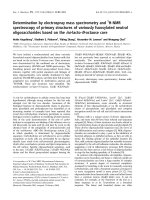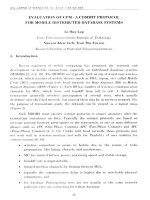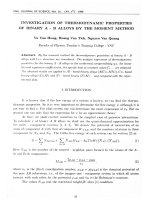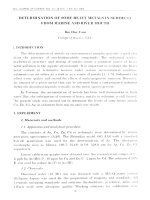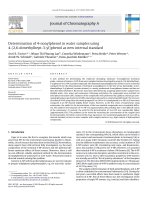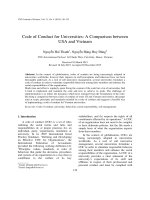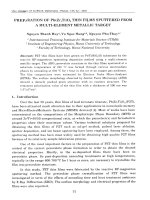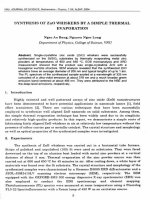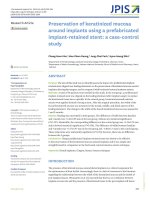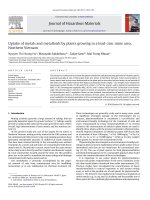DSpace at VNU: Determination of bisphenol A (BPA) by gas chromatography-mass spectrometry and H-1 NMR spectroscopy during curing of epoxy-amine resins
Bạn đang xem bản rút gọn của tài liệu. Xem và tải ngay bản đầy đủ của tài liệu tại đây (333.59 KB, 11 trang )
ARTICLE IN PRESS
POLYMER
TESTING
Polymer Testing 25 (2006) 912–922
www.elsevier.com/locate/polytest
Analysis Method
Determination of bisphenol A (BPA) by gas
chromatography–mass spectrometry and 1H NMR spectroscopy
during curing of epoxy–amine resins
F.X. Perrina,Ã, Thi Minh Hanh Nguyena,b, Thi My Linh Tranb, J.L. Verneta
a
Laboratoire Mate´riaux a` Finalite´s Spe´cifiques (UPRES no. 1356), Universite´ de Toulon et du Var, BP 132, 83957 La Garde Cedex, France
b
Faculte´ de Chimie – Laboratoire de Chimie analytique, Universite´ Nationale de Hanoı¨, Vietnam
Received 6 April 2006; accepted 20 May 2006
Abstract
Two analytical methods were developed to characterize the fate of bisphenol A (BPA) added in low amounts (1–4 wt%)
in two different epoxy–amine–BPA systems, one based on a mixture of aliphatic amine curing agents, diethylene triamine
(DETA) and poly(oxypropylene)diamine (Jeffamine) and the other on the less reactive diaminodiphenylsulphone (DDS)
hardener. The method involves a liquid–liquid extraction (LLE) procedure up to gelation. Identification and quantification
was performed by gas chromatography–mass spectrometry (GC–MS) and proton nuclear magnetic resonance (1H-NMR)
spectroscopy. The data obtained by the two methods are in agreement. The main purpose of this study was to determine
the extent of aryl-etherification in actual complex epoxy/amine formulations. It serves notably to detect potential
contamination of the atmosphere, water, and soil in the area surrounding where the unbound BPA is released.
r 2006 Elsevier Ltd. All rights reserved.
Keywords: Bisphenol A; Epoxy; Curing; GC–MS; NMR spectroscopy
1. Introduction
Epoxy resins are one of the most important
classes of thermosetting polymers. The addition of
additives or modifiers (catalysts, diluents, fillers,
resinous modifiers, elastomeric modification, etc.),
to the two main ingredients is frequently adopted to
change the characteristics of the uncured resin
(rheology, curing kinetics, etc.), or the properties
of the final material (fracture behaviour for
ÃCorresponding author. Tel.: +33 494 142580;
fax: +33 494 142448.
E-mail address: (F.X. Perrin).
0142-9418/$ - see front matter r 2006 Elsevier Ltd. All rights reserved.
doi:10.1016/j.polymertesting.2006.05.015
example). Some formulations proposed in industry
were found to contain small amounts of phenolic
compounds mixed with the amine hardener component. Phenolic compounds are hydrogen donor
molecules and thus could theoretically catalyse the
epoxy-amine reaction by forming a trimolecular
complex facilitating the amine attack, as illustrated
in Scheme 1. The same type of push-pull mechanism
accounts for the autocatalytic nature of the curing
process observed with epoxy/amine systems, which
is related to the accumulation of hydroxyl groups
during curing [1,2].
The formation of ether links during epoxy/amine
cure by reaction between an epoxide group and a
ARTICLE IN PRESS
F.X. Perrin et al. / Polymer Testing 25 (2006) 912–922
913
O
R1
HN
H2C
CH2
CH
CH
O
R2
H O
H O
O
R1
R2
H
Scheme 1. Trimolecular intermediate amine–epoxy–phenol
showing the catalytic effect of a phenol compound on the
amine–epoxy reaction.
hydroxyl group is significant only with certain
epoxy/amine systems and in certain conditions
(stoichiometric excess of epoxide groups, high cure
temperatures, etc.) [3]. The etherification reaction is
also accelerated by tertiary amine (Scheme 2) and
hydroxyl groups (Scheme 3) [4]. Both the tertiary
amine and hydroxy catalysis etherification proceed
through the formation of trimolecular complex, as
shown in Schemes 2 and 3, respectively. Schemes 2
and 3 suggest that phenol compounds in epoxy–amine–phenol ternary systems can be incorporated in
the epoxy network through aryl ether bonds
(Schemes 2 and 3 with R1 ¼ phenyl). Eventually,
they may also accelerate etherification of aliphatic
hydroxyl (present in the starting epoxy material or
formed during the epoxy–amine reaction) with
epoxide (Scheme 2 with R1 ¼ epoxy chain and
R2 ¼ phenyl).
Currently, our knowledge about the reactivity of
phenol compounds with epoxy and epoxy/amine
systems is mainly based on the pioneering work
by Shechter and Wynstra [5] and Shechter et al. [6].
The catalytic effect of phenol for the alcohol–
epoxide etherification [5] and for the amine–epoxy
addition [6] were demonstrated. These studies
were performed on soluble model compounds to
permit the use of conventional analytical methods
to elucidate the reaction mechanism. The danger
with this approach is that the reaction rates and the
reaction paths observed with these monofunctional compounds may be different from the
results obtained on real polyfunctional systems.
For instance, the addition of phenol through aryl
ether bonds was found to strongly depend on the
presence of a base catalyst [6]. Without a catalyst,
phenol reacts with epoxy at a temperature of 200 1C
or higher [5], while the reaction of phenol with
epoxide proceeded at a reasonable rate at 50 1C
in phenol–phenyl glycidyl ether–diethylamine (or
Scheme 2. Trimolecular intermediate showing the catalytic effect
of a hydroxy compound on the etherification reaction (R1 ¼ or
6¼R2).
O
CH
CH2
O
H
R1
NR3
Scheme 3. Trimolecular intermediate showing the catalytic effect
of a tertiary amine on the etherification reaction.
N-methyl aniline) mixtures [6]. In this context, one
of the principle uncertainties arises from the fate of
a phenol compound added to a given polyfunctional
epoxy–amine system. In other words, does the
hindered amine in polyfunctional epoxy–amine
systems exert any catalytic effect toward the aryl
etherification? It also appears fundamental to know
if phenol compound is chemically bound into the
cross-linked network or if it is only physically
bound (hydrogen bonds) for two main reasons: (1)
the way phenol is incorporated into the cured resin
may affect the physical and mechanical properties
of the final material in a different way; (2) the
toxicological activity of phenols should be strictly
considered if a significant amount of phenol remains
not chemically bound to the network. At the present
time, we found that some commercial formulations
contain low amounts of bisphenol A (4,40 -isopropylidenediphenol) (BPA) added in the hardener
component. The low amount of BPA in these
formulations (1–4 wt%) suggest that BPA mainly
serves here as a catalyst for the amine–epoxy
reaction. As far back as 1936, Doods and Lawson
noted oestrogenic activity of BPA [7]. More
recently, BPA was found to be leached from a
polycarbonate flask [8]. It was also found in saliva
collected from patients who were treated with a
DGEBA-based dental sealant [9]. In both cases, the
ARTICLE IN PRESS
914
F.X. Perrin et al. / Polymer Testing 25 (2006) 912–922
leaching of BPA was ascribed to the hydrolysis of
the polymer.
In this paper, we developed analytical tools to
investigate the fate of low amounts of BPA
(1–4 wt%) in two formulations of different reactivity: an epoxy–aliphatic amine–BPA commercial
formulation and a less reactive diglycidyl ether of
bisphenol A (DGEBA)–diaminodiphenylsulphone
(DDS)–BPA formulation. We will also propose a
methodology for the determination of epoxide
equivalent weight (EEW) and component composition in epoxy resins based on DGEBA/DGEBF
mixtures using 1H NMR spectroscopy.
2. Experimental
2.1. Materials
The epoxy resin was a DGEBA–diglycidyl ether
of bisphenol F (DGEBF) mixture (see the next
section for the characterization data) supplied by
REA Industrie (France). DGEBF is used as a
functional diluent to prepare solventless epoxy
formulations. Three different amine hardeners were
tested: a diethylene triamine (DETA)/polyoxypropylene amine/BPA commercial hardener (CH)
having an amino hydrogen equivalent weight
(AEW) of 59 g, jeffamine (Aldrich) with an AEW
of 100 g and 4,40 -diaminodiphenylsulfone (Aldrich,
97%) with an AEW of 62 g.
BPA and naphtalene were supplied by Aldrich.
Water was purified by means of a water purification
system. All other solvents were of analytical reagent
grade (Aldrich) except dichloromethane used for the
LLE of BPA (Fluka, 95%).
2.2. Methods
The samples were prepared by adding appropriate amounts of an amine/BPA solution or BPA
powder to the DGEBA/DGEBF resin either at
room temperature (aliphatic amine-based epoxy) or
at 120 1C (DDS-based epoxy). The specified quantities for the epoxy, amine hardener and BPA
correspond to their molar equivalent of glycidyl
ether, hydrogen amines, hydroxy functionalities,
respectively. After intimate mixing, the viscous
mixture was cast in a teflon mould and isothermally
cured at a temperature related to the reactivity of
the hardener (not greater than 60 and 200 1C,
respectively, for aliphatic and aromatic amines).
Samples (5 g) were taken at definite times during
curing, introduced into an Erlenmayer flask and
cooled quickly to room temperature while placing
the flask in a ice bath.
2.2.1. LLE procedure (before gelation)
About 50 ml of an aqueous solution containing
sodium hydroxide (0.3 M) and sodium chloride
(100 g/l) was added to a 50 ml ether solution of 5 g
of the epoxy/amine/BPA sample. After vigorous
stirring for 10 min at room temperature, the
aqueous phase was extracted and treated with
10% hydrochloric acid to obtain an acidic pH
($1–2) solution. NaCl was added to the acidic
solution to obtain a 200 g/l NaCl concentration.
Then, the aqueous extract was extracted three times
with 50 ml of dichloromethane by vigorous shaking
for 10 min. The extracts were treated with 1 g of
magnesium sulphate and then concentrated to near
dryness on a rotary evaporator under a gentle flow
of N2.
2.2.2. Solid– liquid
extraction
(SLE)
(after
gelation)
About 1–5 g of the epoxy/amine/BPA gelled
material was ground to fine powder at the temperature of liquid nitrogen using a freezer mill SPEX
Certiprep 6750. The powder was extracted twice
with 20 ml of methanol by shaking overnight. The
combined extracts (40 ml) were either concentrated
(for NMR analysis) or used to prepare methanol
solutions for GC/MS analysis.
2.2.3. 1H NMR analysis
1
H NMR spectra were measured at room
temperature on a Brucker AV400 spectrometer
operating at 400 MHz, using deuterated dimethylsulphoxide (DMSO-d6) as a solvent and naphtalene
as an internal standard.
2.2.4. GC-MS analysis
Chromatographic measurements were performed
with a gas chromatograph HP 6890 equipped with a
mass spectrometer HP 6890. The carrier gas was
helium and the flow rate was 1 ml/min. The column
was a fused silica capillary (30 m  0.25 mm
i.d. Â 0.25 mm film thickness). The temperature of
the injection port was 280 1C using a split ratio of
40/1. The oven temperature was held at 150 1C for
2 min, then elevated to 280 1C at 30 1C/min and
finally held at 280 1C for 2 min. The interface
temperature was 300 1C and the energy of ionizing
electron was 70 eV. The MS was operated in scan
ARTICLE IN PRESS
F.X. Perrin et al. / Polymer Testing 25 (2006) 912–922
mode with a scan range from m/z 45 to 300.
Quantification was done by an internal standard
method using naphthalene as an internal standard.
Monitored ions were m/z (molecular ion of
naphthalene) and 228.1 (molecular ion of BPA).
complicated by the presence in the resin of two
different epoxies of very close chemical structure.
The average molecular weight M n of the DGEBA/
DGEBF resin may be defined as
Mn ¼
3. Results and discussion
3.1. Characterization of the DGEBA/DGEBF
commercial mixture
The DGEBA/DGEBF commercial mixture was
characterized by 1H NMR spectroscopy. Fig. 1
illustrates the 1H-NMR spectrum of the DGEBA/
DGEBF mixture. All the resonance signals have
been attributed to the corresponding protons of the
DGEBA and DGEBF structures.
Recently, the 1H NMR was found to constitute
an alternative to the classical titration methods to
determine the EEW of low molecular weight
DGEBA resins [10]. Here, the problem is somewhat
915
x1 M n1 þ x2 M n2
,
x1 þ x2
(1)
where x1 and x2 are mole number of DGEBA and
DGEBF contained in 1 g of mixture, respectively,
and M n1 and M n2 are the average molecular weight
of DGEBA and DGEBF, respectively.
M n1 and M n2 are related to the polymerization
degree n1 and n2 by the relation:
M n1 ¼ 284n1 þ 340,
(2)
M n2 ¼ 256n2 þ 312.
(3)
Considering the idealized structures in Fig. 1
where one epoxy group terminates each end of the
DGEBA and DGEBF resins, the average EEW is
one-half the average molecular weight of the
25000
20000
15000
10000
50000
0
7.0
6.0
5.0
4.0
ppm (t1)
3.0
2.0
1.0
Fig. 1. 1H NMR spectrum of the DGEBA/DGEBF commercial mixture.
0.0
ARTICLE IN PRESS
F.X. Perrin et al. / Polymer Testing 25 (2006) 912–922
916
DGEBA/DGEBF mixture:
EEW ¼
x1 ð284n1 þ 340Þ þ x2 ð256n2 þ 312Þ
.
2ðx1 þ x2 Þ
(4)
EEW can be determined measuring the integrals
I1, I2 and I3 corresponding, respectively, to the
aromatic protons (peaks a and b), the epoxide
group protons (peaks e, f and g) and the benzylic
methyl protons (peak h).
Indeed, the idealized structures shown in Fig. 1 give
R1 ¼
R2 ¼
I 1 8½x1 ðn1 þ 1Þ þ x2 ðn2 þ 1Þ
,
¼
6ðx1 þ x2 Þ
I2
(5)
I3 6x1ðn1 þ 1Þ
¼
.
I2
6ðx1 þ x2Þ
(6)
Substituting Eq. (6) into Eq. (5) and re-arranging,
we get
3I 1 À 4I 3 x2 ðn2 þ 1Þ
R3 ¼
.
¼
ðx1 þ x2 Þ
4I 2
(7)
Eq. (4) can be re-arranged to be expressed as
function of the integral ratios R1 and R2 (Eqs. (5) and
(6)):
EEW ¼ 96R1 þ 14R2 þ 28.
(8)
The EEW of the DGEBA/DGEBF commercial
mixture calculated from Eq. (8) was 171.271.2 (value
at 95% confidence interval determined from five
different aliquots).
An EEW of 17472.7 (value at 95% confidence
interval determined from five chemical analysis) was
found by acid titration using the pyridinium
chloride–pyridine method [11]. The data found by
1
H NMR spectroscopy are in good agreement to
those obtained from the classical chemical titration.
The average polymerization degree, n¯ , can be
defined by the following equation:
x1 n1 þ x2 n2
n¯ ¼
.
x 1 þ x2
½x1 ðn1 þ 1Þ þ x2 ðn2 þ 1Þ À ðx1 þ x2 Þ
.
ðx1 þ x2 Þ
(9)
(10)
(11)
The average polymerization degree was estimated
by Eq. (11):
n¯ ¼ 0:08.
y1
,
284n1 þ 340
(12)
x2 ¼
y2
.
256n2 þ 312
(13)
Re-arranging Eqs. (12) and (13), we get
x1 ½284ðn1 þ 1Þ þ 56 ¼ y1 ,
(14)
x2 ½256ðn2 þ 1Þ þ 56 ¼ y2 .
(15)
Substituting Eq. (6) into Eq. (14) and Eq. (7) into
Eq. (15), the following equations can be obtained:
284R2 ðx1 þ x2 Þ þ 56x1 ¼ y1 ,
(16)
256R3 ðx1 þ x2 Þ þ 56x2 ¼ y2 .
(17)
Addition of Eqs. (16) and (17) gives
ðx1 þ x2 Þ ¼
1
.
284R2 þ 256R3 þ 56
(18)
Besides, from Eqs. (6) and (7), it is clear that
x1 oR2 ðx1 þ x2 Þ,
(19)
x2 oR3 ðx1 þ x2 Þ.
(20)
Substituting the inequality Eqs. (19) and (20) in
Eqs. (16) and (17), then, considering Eq. (18) we get:
312R3
340R2
oy1 o
.
284R2 þ 256R3 þ 56
284R2 þ 256R3 þ 56
(21)
Therefore,
n¯ ¼ 68R1 À 1.
x1 ¼
1À
Eq. (8) can be re-written in order to reveal the
expression of the integral ratio R1:
n¯ ¼
The low value of n¯ agrees with the low intensity of
the multiplet at d ¼ 4.1 ppm (peak i ascribed to the
aliphatic carbinol methine) and confirms that the
epoxy resin contains a small fraction of oligomers
(n1 and n240).
The mole number x1 and x2 are related with the
weight fraction of DGEBA, y1, and DGEBF, y2, as
follows:
Eq. (21) is a general expression that can be used
for estimating the interval of the weight fractions of
DGEBA and DGEBF in mixtures of these components.
For the commercial epoxy used in this study, the
width of the interval was found to be very low:
0:34oy1 o0:35.
These data are in excellent agreement with the
data given by the supplier: 65 wt% of DGEBF (and
35% of DGEBA).
ARTICLE IN PRESS
F.X. Perrin et al. / Polymer Testing 25 (2006) 912–922
3.2. Preconcentration procedure
three successive extractions (see the next section for
the determination of the extraction yield). We noted
that the ionic strength of the aqueous phase was one
of the key parameters that affects both the yield of
BPA recovery and the efficiency of the separation.
The ionic strength was adjusted using NaCl to
obtain NaCl concentrations from 0 to 300 g/L. A
100 g/L NaCl concentration in the aqueous alkaline
phase at the first step of the LLE ensures that a
major fraction of the epoxy resin remains in the
ether phase. Besides, a 200 g/L NaCl concentration
in the acidic aqueous phase at the second step of the
LLE was found to be necessary to totally extract
BPA in dichloromethane by a salting-out effect.
3.3. Analytical determination of BPA
1.514
3.3.1. 1H NMR spectroscopy: extraction yield
Fig. 2 shows a typical 1H NMR spectrum of a
complex epoxy–amine–BPA mixture (Fig. 2(a))
together with the spectrum of the organic phase
6.640
6.977
7.506
7.905
9.137
A preconcentration procedure was essential to
avoid strong interferences of amine and epoxy
components during analysis. We adopted a liquid–liquid extraction method and a SLE method,
respectively, before and after the gelation point of
the mixture. The optimization of the extraction
procedure was carried out on a stoechiometric
DGEBA/DGEBF–jeffamine–BPA (1 wt%) mixture.
For the LLE procedure, BPA was extracted in two
steps: in a first step, BPA was totally removed as its
dissociated form in the alkaline aqueous phase. The
relatively hydrosoluble amine hardener was found
to be present in great amounts in the aqueous phase.
In the second step, the aqueous phase was acidified
to form the amine salt and, thus, to selectively
extract BPA in an organic solvent. Ethyl ether,
n-hexane and dichloromethane were tested as
extraction solvents. Dichloromethane was the most
efficient, giving nearly 100% recovery of BPA after
917
naphtalene
Hc
biphenol A
(a)
Hd
Hao
Hbo
Ha
Hb
H20
DMSO
x
9.0
8.0
7.0
6.0
5.0
ppm (t1)
4.0
(b)
3.0
2.0
1.0
Fig. 2. 1H NMR spectrum of a stoechiometric DGEBA/DGEBF–jeffamine–BPA (1 wt%) mixture before (a) and after (b) the LLE
procedure.
ARTICLE IN PRESS
918
F.X. Perrin et al. / Polymer Testing 25 (2006) 912–922
Fig. 3. Typical chromatogram of a LLE residue (shown here is a DGEBA/DGEBF–jeffamine–BPA(1%) mixture after 2 h at room
temperature): (1) naphthalene, and (2) BPA.
Fig. 4. Mass spectra obtained in scan mode for BPA.
ARTICLE IN PRESS
F.X. Perrin et al. / Polymer Testing 25 (2006) 912–922
(Fig. 2(b)) after the LLE procedure. The 1H NMR
spectrum of Fig. 2(b) is dominated by the proton
signals of BPA (aromatic doublets at 6.64 and
6.98 ppm and methyl singlet at 1.51 ppm), while the
proton signals of BPA are barely perceptible in
Fig. 2(a). This reveals the efficiency of the separation, although minor amounts of the epoxy resin
(small peaks at 7.05 and 6.77 ppm) are still present
in the organic extract after extraction.
The wt% recovery of BPA was determined by
adding naphthalene as an internal standard to the
organic residue obtained from the LLE procedure.
The two doublets at 7.5 and 7.9 ppm are the
absorption of the aromatic protons of the standard.
The wt% of BPA in the epoxy/amine mixture is
calculated by comparing the integral of the
four aromatic protons of BPA at 6.98 ppm (Ia) with
the integral of the four aromatic protons of
919
naphthalene at 7.9 ppm (Iao):
%BPA ¼
W N Ia M BPA
 100,
W R I ao M N
(22)
where WN is the weight of naphthalene, WR is the
weight of resin and MBPA and MN are the molecular
weight of BPA and naphthalene, respectively.
The calculated wt% of BPA from Eq. (22) was
compared to the theoretical amount of BPA in
different epoxy–amine–BPA mixtures of known
composition (0.5–2 wt% BPA) and just prepared
at room temperature: the extraction yield was
systematically higher than 95%.
The same methodology was followed to determine the efficiency of SLE from a stoichiometric
epoxy/CM blend cured at 20 1C for 14 days. The
extraction yield of BPA was found to be near 100%
as could be forecast from the low curie temperature.
1
GCMS
(1-αBPA)
0.8
RMN
0.6
0.4
0.2
0
0
500
1000
1500
2000
(a)
2500 3000
time (min)
3500
4000
4500
5000
1
GCMS
(1-αBPA)
0.8
RMN
0.6
0.4
0.2
0
0
(b)
1000
2000
3000
4000
5000
time (min)
Fig. 5. Fraction of non-reacted BPA (1ÀaBPA) in (a) epoxy/BPA (1/0.076) and (b) epoxy/DDS/BPA (1/1/0.076) blends both cured at
100 1C.
ARTICLE IN PRESS
F.X. Perrin et al. / Polymer Testing 25 (2006) 912–922
920
3.3.2. GC/MS analysis
GC/MS has been used to analyse phenolic analytes
either directly [12] or after silyl derivatization [13]. By
incorporating a silyl group to a phenolic compound,
better reproducibility, sensitivity and resolution can be
achieved for the gas chromatographic analysis. This
work is not dedicated to analysis of traces of polar
analytes or to complex mixtures of phenol compounds
with very similar chemical structure. Thus, a direct
analysis of the LLE and SLE residues was performed.
A typical chromatogram of the phenolic analyte
obtained after the LLE procedure is shown in Fig. 3.
Only 7 min were necessary to complete the analysis.
The mass spectrum obtained in scan mode for the
compound (2) of Fig. 3 is shown in Fig. 4 and reveals
the molecular ion of BPA at m/z 228 and a base peak
at m/z 213 corresponding to loss of a methyl group.
The GC-MS and 1H NMR analysis were found to
give very similar results, as inferred from Fig. 5
which compares the BPA content in epoxy/BPA and
epoxy/DDS/BPA blends determined from both
methods. The fate of BPA in both blends will be
discussed in the next two sections.
3.4. The fate of BPA in epoxy/BPA and epoxy/
amine/BPA blends
Fig. 6 compares the fate of BPA in stoichiometric epoxy/amine blends from either aliphatic or
aromatic hardener.
BPA is integrally recovered from the totally cured
epoxy/jeffamine blend. In such resins, BPA is only
linked to the polymer network though physical
bonds (hydrogen bonds) and is thus prone to be
readily released in the environment. Conversely, the
higher temperature required to cure epoxy resins
with aromatic hardener like DDS favours the
etherification between BPA and epoxy. DSC analysis (not shown) showed that BPA does not induce a
change in Tg for epoxy/jeffamine blends (Tg onset
measured during the second ramp near 32 1C) while
a 10 1C decrease of the Tg of epoxy/DDS/BPA (1/1/
0.076) compared to the Tg of epoxy/DDS (1/1) was
noted (respective Tg onset of 164 and 174 1C).
Owing to the low amount of free BPA (o10% of
the initial content from Fig. 6) in the totally cured
DDS based resins, the plasticization induced by
BPA can undoubtedly be related to the chemical
alteration of the polymer network (internal plasticization) rather than an external plasticization. Low
amounts of BPA (few wt%) incorporated in epoxy/
aliphatic amine blends only acts to catalyse the
epoxy–amine reaction, as suggested by the measured gel time of 161 min in epoxy/jeffamine (1/1)
blend compared to 82 min in epoxy/jeffamine/BPA
(1/1/0.076) blend, both cured at 60 1C.
Fig. 6 also reveals a clear increase in the rate of
etherification in the course of the reticulation at the
three investigated temperatures. This acceleration
must be related to the accumulation of hydroxy
1
DDS (200°C)
DDS (150°C)
0.8
DDS (100°C)
Jeffamine (60°C)
(1-αBPA)
0.6
0.4
0.2
0
0
100
200
300
400
time (min)
500
600
700
800
Fig. 6. Fraction of non-reacted BPA (1ÀaBPA) in epoxy/amine/BPA (1/1/0.076) blends isothermally cured.
ARTICLE IN PRESS
F.X. Perrin et al. / Polymer Testing 25 (2006) 912–922
and/or tertiary amine during the epoxy/amine
reaction. This result suggests that trimolecular
complexes such as shown in Schemes 2 and 3 are
involved during the epoxy/BPA reaction. It is
noteworthy that this is not strictly speaking an
autocatalytic effect. Further experimental evidence
of such a catalytic effect is provided by comparing
the change in BPA content in epoxy/BPA (1/0.076)
and epoxy/DDS/BPA (1/1/0.076) mixtures cured
under the same conditions (Fig. 7). Irrespective of
1
921
the cure temperature, the rate of the etherification
reaction between epoxy and BPA is found to be
higher when the amine hardener is incorporated
into the epoxy/BPA blend.
Since BPA/epoxy/BPA trimolecular complexes
may be potentially involved as soon as the
initial times of the reaction, it is believed that
tertiary amines, despite their steric crowding,
exert a more efficient catalytic effect than hydroxy
groups.
without DDS
with DDS
(1-αBPA)
0.8
200°C
0.6
0.4
0.2
0
0
1
200
400
600
time (min)
800
1000
without DDS
with DDS
0.8
(1-αBPA)
150°C
0.6
0.4
0.2
0
0
1
500
1000
1500
time (min)
2000
2500
3000
without DDS
with DDS
(1-αBPA)
0.8
100°C
0.6
0.4
0.2
0
0
1000
2000
3000
time (min)
4000
5000
Fig. 7. Fraction of non-reacted BPA (1ÀaBPA) in isothermally cured epoxy/BPA (1/0.076) and epoxy/DDS/BPA (1/1/0.076) blends.
ARTICLE IN PRESS
922
F.X. Perrin et al. / Polymer Testing 25 (2006) 912–922
4. Conclusion
In the first part of this paper, we showed that 1H
NMR spectroscopy was an efficient tool to characterize unknown DGEBA/DGEBF epoxy mixtures: the general equations allowing the
estimation of the EEW (Eq. (8)), the average
polymerization degree (Eq. (11)) and the weight
fraction of each component (Eq. (21)) have been
determined. The values obtained by the proposed
methodology agreed well with the EEW value
obtained from the classical pyridinium chloride–
pyridine titration method and with the weight
fraction data given by the supplier.
The main purpose of this work was to develop
analytical tools to determine the fate of phenolic
compounds incorporated to complex epoxy/amine
mixtures. Both GC/MS and 1H NMR spectroscopy
gave reproducible and convenient results. However,
1
H NMR seems more appropriate to determine the
fate of BPA during curing owing to the relatively
high amount of analytes on looking at the high
sensitivity of GC/MS analysis. 1H NMR spectroscopy results are also less dependant than GC/MS
on the interaction of other chemicals such as epoxy
or amine residues not separated during the LLE
procedure. Conversely, GC/MS, being a more
sensitive method, should be preferred to 1H NMR
spectroscopy when the aim is to determine the
extent of leaching of BPA from the cured material
into a specific environment such as water for
example.
In this study, the BPA was found to act only as a
catalyst for the epoxy–amine reaction in the reactive
aliphatic amine system raising the problem of its
release in the environment. Apart from its catalytic
effect, BPA was incorporated as aryl-ether bonds to
the epoxy–DDS network when the cure temperatures are higher than 100 1C. Besides, a clear
catalytic effect of tertiary amine and hydroxy
groups for the etherification reaction has been
revealed.
It must finally be noted that the analytical
methodology developed here may also be adapted
to phenol compounds other than BPA, either to
determine their fate during curing or their release in
a specific environment. An example is nonyl phenol
which has found wide use in many aminecured epoxy formulations, functioning as a blush
preventative, flexibilizer and polymerization
accelerator.
Acknowledgement
Grateful acknowledgement is due to AUF for its
financial support.
References
[1] J. Mijovic, A. Fishbain, J. Wijaya, Mechanistic Modeling of
epoxy–amine kinetics 1. Model compound study, Macromolecules 25 (1992) 979.
[2] H. Xie, B. Liu, Q. Sun, Z. Yuan, J. Shen, R. Cheng, Cure
kinetic study of carbon nanofibers/epoxy composites by
isothermal DSC, J. Appl. Polym. Sci. 96 (2005) 329.
[3] L. Xu, J.R. Schlup, Etherification versus amine addition
during epoxy resin/amine cure: an in situ study using nearinfrared spectroscopy, J. Appl. Polym. Sci. 67 (5) (1998) 895.
[4] I.T. Smith, The mechanism of the crosslinking of epoxide
resins by amines, Polymer 2 (1961) 95.
[5] L. Shechter, J. Wynstra, Glycidyl ether reactions with
alcohols, phenols, carboxylic acids and acid anhydrides,
Ind. Eng. Chem. 48 (1956) 86.
[6] L. Shechter, J. Wynstra, R.P. Kurkjy, Glycidyl ether
reactions with amines, Ind. Eng. Chem. 48 (1956) 94.
[7] E.C. Doods, W. Lawson, Nature (1936)996.
[8] A.V. Krishnan, P.S. Starhis, F. Permuth, L. Tokes, D.
Feldman, Bisphenol A: an estrogenic substance is released
from polycarbonate flasks during autoclaving, Endocrinology 132 (1993) 2279.
[9] N. Olea, R. Pulgar, P. Perez, F. Olea-Serrano, A. Rivas, A.
Novillo-Tertrell, V. Pedraza, A.M. Soto, C. Sonnenschein,
Estrogenicity of resin-based composites and sealants used in
dentistry, Environ. Health Perspect. 104 (1996) 298.
[10] F.G. Garcia, B.G. Soares, Determination of the epoxide
equivalent weight of epoxy resins based on diglyclidyl ether
of bisphenol A (DGEBA) by proton nuclear magnetic
resonance, Polym. Test. 22 (2003) 51.
[11] H. Lee, K. Neville, Handbook of Epoxy Resins, McGrawHill Book Company, New York, 1967, pp. 4–14.
[12] T. Yamamoto, A. Yasuhara, Quantities of bisphenol A
leached from plastic waste samples, Chemosphere 38 (11)
(1999) 2569.
[13] D. Li, J. Park, J.-R. Oh, Silyl derivatization of alkylphenols,
chlorophenols and bisphenol A for simultaneous GC/MS
determination, Anal. Chem. 73 (2001) 3089.
